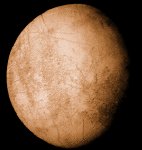|
Europa
The
@stro object for the week of 01/10/2000

image
courtesy of SEDS
Europa. Europa
is one of the largest moons in the solar system and orbits the planet
Jupiter. It was first discovered in 1610 by Galileo. It has a very
smooth appearance except for ridges and a few meteor impact craters.
These ridges, it is theorized, are the result of tidal forces caused
by liquid water shifting under its surface due to the gravitational
forces of Jupiter. This implies that the surface of Europa is actually
a layer of ice mixed with other minerals. Should the presence of
liquid water be confirmed it could indicate another place in the
solar system (Mars being the first) that deserves some investigation
of past or present life. Europa is easily visible in a small telescope
if it is not behind Jupiter from our perspective. The Galileo
spacecraft in orbit around Jupiter made a New Year's day fly-by
of Europa and its data is forthcoming to the public.
| Current
information for Europa (info for Jupiter): |
| Rise: 1140
PST |
| Set: 0034
PST |
| Magnitude:
n/a |
| Constellation:
Pisces |
| Phase:
n/a |
more
info...
|